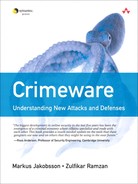Preface
Traditionally, malware has been thought of as a purely technical threat, relying principally on technical vulnerabilities for infection. Its authors were motivated by intellectual curiosity, and sometimes by competition with other malware authors.
This book draws attention to the fact that this is all history. Infection vectors of today take advantage of social context, employ deceit, and may use data-mining techniques to tailor attacks to the intended victims. Their goal is profit or political power. Malware become crimeware. That is, malware has moved out of basements and college dorms, and is now a tool firmly placed in the hands of organized crime, terror organizations, and aggressive governments. This transformation comes at a time when society increasingly has come to depend on the Internet for its structure and stability, and it raises a worrisome question: What will happen next? This book tries to answer that question by a careful exposition of what crimeware is, how it behaves, and what trends are evident.
The book is written for readers from a wide array of backgrounds. Most sections and chapters start out describing a given angle from a bird’s-eye view, using language that makes the subject approachable to readers without deep technical knowledge. The chapters and sections then delve into more detail, often concluding with a degree of technical detail that may be of interest only to security researchers. It is up to you to decide when you understand enough of a given issue and are ready to turn to another chapter.
Recognizing that today’s professionals are often pressed for time, this book is written so that each chapter is relatively self-contained. Rather than having each chapter be sequentially dependent on preceding chapters, you can safely peruse a specific chapter of interest and skip back and forth as desired. Each chapter was contributed by a different set of authors, each of whom provides a different voice and unique perspective on the issue of crimeware.
This book is meant for anyone with an interest in crimeware, computer security, and eventually, the survivability of the Internet. It is not meant only for people with a technical background. Rather, it is also appropriate for makers of laws and policies, user interface designers, and companies concerned with user education. The book is not intended as a guide to securing one’s system, but rather as a guide to determining what the problem really is and what it will become.
Although we often use recent examples of attacks to highlight and explain issues of interest, focus here is on the underlying trends, principles, and techniques. When the next wave of attacks appears—undoubtedly using new technical vulnerabilities and new psychological twists—then the same principles will still hold. Thus, this book is meant to remain a useful reference for years to come, in a field characterized by change. We are proud to say that we think we have achieved this contradictory balance, and we hope that you will agree.
Acknowledgments
We are indebted to our expert contributors, who have helped make this book what it is by offering their valuable and unique insights, and selflessly donated their time to advance the public’s knowledge of crimeware. The following researchers helped us provide their view of the problem: Shane Balfe, Jeffrey Bardzell, Shaowen Bardzell, Dan Boneh, Fred H. Cate, David Cole, Vittoria Colizza, Bruno Crispo, Neil Daswani, Aaron Emigh, Peter Ferrie, Oliver Friedrichs, Eimear Gallery, Mona Gandhi, Kourosh Gharachorloo, Shuman Ghosemajumder, Minaxi Gupta, James Hoagland, Hao Hu, Andrew Kalafut, Gary McGraw, Chris J. Mitchell, John Mitchell, Steven Myers, Chris Mysen, Tyler Pace, Kenneth G. Paterson, Prashant Pathak, Vinay Rao, Jacob Ratkiewicz, Melanie Rieback, Sourabh Satish, Sukamol Srikwan, Sid Stamm, Andrew Tanenbaum, Alex Tsow, Alessandro Vespignani, Xiaofeng Wang, Stephen Weis, Susanne Wetzel, Ollie Whitehouse, Liu Yang, and the Google Ad Traffic Quality Team.
In addition, Markus wishes to thank his graduate students, who have helped with everything from performing LaTeX conversions to being experiment subjects, and many of whose research results are part of this book. Zulfikar wishes to thank Oliver Friedrichs and the rest of the Symantec Advanced Threat Research team (as well as his colleagues throughout Symantec) for affording him the opportunity to work on this book and for engaging in countless stimulating discussions on these topics.
We also both want to acknowledge the help and guidance we have received from Jessica Goldstein and Romny French at Addison-Wesley.
Finally, we want to thank our understanding spouses and families, who have seen much too little of us in the hectic months during which we labored on getting the book ready for publication.
Markus Jakobsson
Palo Alto, California
January, 2008
Zulfikar Ramzan
Mountain View, California
January, 2008
